Remarketing lists for search ads (RLSA) allow you to target people that have been to your website with your campaigns.
Since these users know what you have to offer, they are much more valuable compared to others.
So in this article, we’ll take a closer look at what RLSAs is, and how it’s different from other types of remarketing.
We’ll also look at the 5 most effective ways to use them inside of your Google Ads account.
Let’s get into it.
Table of Contents
What Are Remarketing Lists for Search Ads (RLSA)?
Remarketing lists for search ads is an audience targeting option that enables you to reach people that have visited your website when they search for relevant keywords on Google.
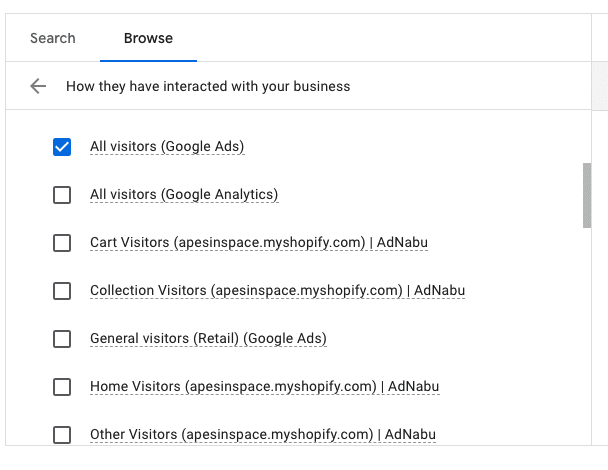
Now, there’s a lot to unpack from that statement, but don’t worry; we’ll address it step by step.
For starters, “remarketing lists for search ads” is a mouthful, so it’s usually referred to as RLSA. Alternative names for this targeting option include search remarketing or paid search retargeting.
RLSA lets you sell to people who looked at products on your site before but weren’t ready to buy yet. So they are still searching for the product online.
So you serve ads to users who:
- are part of a remarketing audience in your Google Ads account; and
- search for a relevant search query in Google
Also, you can turn this RLSA definition around, as Google puts it: “(to) customize your search ads campaign for people who have previously visited your site.”
How Do Remarketing Lists for Search Ads Work?
Like any other remarketing option, you first need to have your remarketing tags configured on your website.
That allows you to create specific remarketing audiences, depending on what visitors have done on your site.
Then, through RLSA, you can add these remarketing audiences to your Search or Shopping campaigns.
This allows you to tailor ads, set bids, and select specific keywords for that group set of visitors.
In theory, this works great because your conversion rates will go up since your ad messaging is more relevant to the users targeted with RLSA.
So what’s the catch?
The Reach of RLSA
Because users need to satisfy both conditions to be eligible to use with RLSA, the number of users in your audience often is pretty small.
That means that you need to have a lot of website visitors to make a dedicated RLSA campaign work. (We’re talking 100,000 visits/mo or more.)
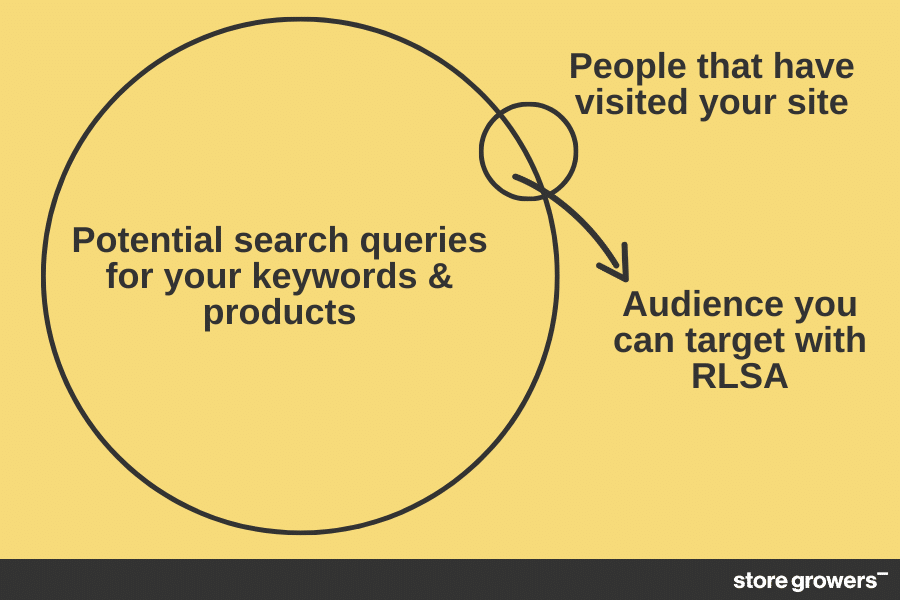
Next, let’s see how remarketing lists for search ads are different from other types of remarketing.
Remarketing Lists for Search Ads vs. Display Remarketing
When it comes to remarketing, there are a few options inside Google Ads.
There are two main types of remarketing:
- Display Remarketing: targets users outside of the search results
- Search Remarketing: targets users in the search results
Display remarketing is the most common way of retargeting website visitors.
Because both types of remarketing use the same remarketing tags, advertisers often confuse display remarketing with search remarketing (RLSA).
But that’s the only thing they have in common. The list of differences is much longer:
Different Campaign Types
RLSA is available on Search and Shopping campaigns.
While Display, YouTube, or Performance Max campaigns, can show Display remarketing ads.
Ad Format
RLSA ads are text-based, just like any other search ad.
Display remarketing ads are available in more than one format (text, image, video), their actual form depends on the placement where the ad is shown.
With static (or standard) remarketing, the ads target groups of users. With dynamic remarketing, you serve personalized ads which correspond with the online actions users took when they visited your website. For example, if the user opened a product page, a dynamic retargeting ad would feature the exact product.
While static remarketing would just show a banner.
Eligibility Criteria
With RLSA, you need at least 1,000 users in the audience to be able to use the audience segment.
One way to increase the audience size is to increase how long users are a part of your audience. The maximum length is 540 days. But you need to ask yourself whether a visitor that’s been to your site 1.5 years ago is still interested.
With Display, you only need 100 users in the audience to be able to show ads to them.
Benefits of Using Remarketing Lists for Search Ads
Remarketing usually is an effective campaign type because of the high purchase intent of users that click which often leads to a good return on investment.
But Remarketing Lists for Search Ads have a few unique benefits like optimized bidding, customizing ad copy, and targeting specific keywords.
Optimize Bids
With RLSA, you can set different bids depending on the criteria of a user. Like the number of visited pages, or how far in the purchase process users ended up.
For each different group, you can set a specific bid depending on how valuable those users are to you.
For example, you can bid a 40% higher max CPC for visitors that started checkout but didn’t complete a purchase.
We’ll talk about more examples in the next section of this article.
Target Broader Keywords
If you’re running dedicated RLSA campaigns, meaning that you’re ONLY targeting people that are part of your remarketing audience, you can target broader, more generic keywords.
Very generic search queries usually have a high search volume associated with them.
This can quickly get expensive as the conversion rate for these keywords often is low as well, since it’s unclear what products a user is really interested in.
With RLSA, you have one advantage though.
Because you know they’ve been to your website and have seen your products, you know that if they search for that generic search query, your products and ad will be highly relevant.
So instead of paying for all users that search for a particular query, now you’re just honing in on the ones that have shown interest before.
This allows you to run campaigns with very different keywords compared to the campaigns that target all users.
Customize Ad Copy
Running dedicated RLSA campaigns, also gives you an additional thing to try.
And that is to customize the ad text depending on which audience they’re part of.
For instance, if a user puts a product in their shopping cart but did not proceed to checkout, you can customize the ad copy to offer a 10% discount and entice them to convert.
5 Ways To Use Remarketing Lists for Search Ads
If you’ve never used remarketing lists for search ads, the concept might sound pretty abstract.
So in this section, I want to show you how RLSAs are actually used in practice through five different use cases.
1 – Adjust bids according to the user’s buyer journey phase
The conventional wisdom is to bid more on those users who are ready to take action. Remarketing tags provide data on the pages website visitors browsed before leaving your site (product viewers, cart abandoners, converters). So with RLSA, you can adjust bids to match their level of interest.
For instance, if a visitor has seen a product page, and they search for a specific keyword, increase the bids by 20%.
And if they are cart abandoners, increase bids by 70%.
Do note that these are just examples, and the actual percentages may vary across industries, depending on the specifics of your situation.
2 – Bid on highly competitive keywords
Competitive keywords are expensive when you target them in a classic search campaign. This is especially true for generic terms like “black dress” or “dress”.
However, if you increase bids on users who visited your site and search for a competitive keyword, you might get a cost per conversion that is acceptable for your business.
For example, if they’ve searched for “black dress” and have previously visited your site, you will have a much higher likelihood of making a sale compared to a visitor that has never been to your site.
It’s a great hack for advertising on keywords that are too expensive to pursue in a non-RLSA campaign.
3 – Bid to cross-sell or upsell existing customers
You can also target existing customers with RLSA to drive additional conversions.
This works well if you offer a wide variety of products on your site or if customers purchase from you regularly.
For example, if you sell a dog leash and also dog food, buyers of either product will also be a good match for the other product (cross-sell).
4 – Bid higher on your competitor’s brand
If someone has visited your website and then they go back to Google to look for your competitor, it might be interesting to advertise on those searches.
Bidding on your competitor’s brand is not always profitable, so this method allows you to cut back on ad spending, and only show in cases where you’re already a part of the consideration set.
5 – Bid higher based on the time of interaction
As you might expect, recency is super important with remarketing.
Targeting people that have visited your site 2 days ago is much more likely to lead to a sale compared to people that visited a month ago.
With RLSA, you can reflect that difference in your bids. The longer it’s been since their last visit, the lower the bid.
For example, you could have a remarketing audience segment of people that:
- Visited yesterday
- Visited 2-3 days ago
- Visited 4-6 days ago
- Visited more than 7 days ago
Seasonality can play a role too. If customer purchase intent is higher during a particular period, you can increase the bids to get in front of more users.
For example, in winter, car batteries tend to die the most, so bid higher when night temperatures drop.
Search Remarketing and Audience Size
As you can see from the previous section, there are lots of great ways to use RLSA campaigns.
But audience size and traffic volume play an important role in deciding which possibilities you have access to.
If you’re not getting that much traffic, you might not be able to capitalize on certain use cases.
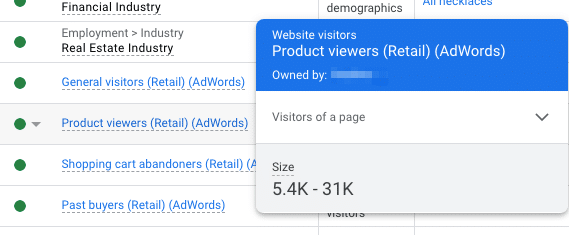
Let me show you an example:
In the screenshot above, you can see that the “Product viewers (Retail)” audience has a size of 5,400 – 31,000 users.
This is part of an account that I manage. And this audience is used in an RLSA campaign and it got 267 clicks over a period of 30 days.
That’s just a trickle of traffic. Because if your website has an average conversion rate of 1%, that would result in 2.7 sales.
But if you got 31,000 users on your website, you made 310 sales in that same period.
So you can see that a dedicated RLSA campaign in this case isn’t really worth the effort.
In fact, I don’t recommend you run a dedicated RLSA campaign if you get less than 100,000 users per month.
This doesn’t mean that you should forget all about RLSA if you run a small ecommerce store, but you need to be aware of the limitations.
So let’s look at how to handle RLSA if you don’t get a lot of traffic.
RLSA for Small Ecommerce Stores
For stores with less than 100k visits/mo, RLSA will be part of your existing campaigns.
By default, Google Ads creates 4 different remarketing audiences, so depending on the traffic, you can use:
- All visitors
- Product viewers
- Shopping cart abandoners
- Converters
For most stores, that means they’re only able to leverage #1 or #2. If you’re using audiences that come from Google Analytics, you will also need to respect the 1000 users minimum. So you can’t go overboard with segmentation.
Next, you will add these audiences to existing campaigns under Observation mode first.
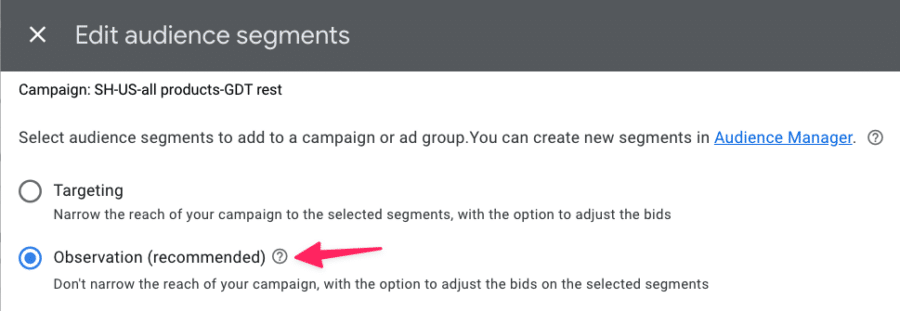
Then, as your campaigns get more data, you can adjust bids as discussed above.
RLSA for High Traffic Ecommerce Stores
Obviously, you have more options for RLSA targeting when you get a lot of traffic (more than 100K visitors per month). You can add search remarketing to existing campaigns or start a dedicated campaign.
If you want to start a dedicated RLSA campaign, you need to add all audiences in Targeting mode (as opposed to Observation mode for existing campaigns).
This will allow you to set bids only for users who are on the lists.
But, before you can do all that, you first need to set up RLSA.
How to Set Up RLSA campaigns
As mentioned before, the first step is to make sure remarketing tags have been added to your site and have been configured correctly.
There are two ways to create remarketing audiences: through Google Ads and Google Analytics.
Once you have a remarketing list, there are two ways to use it in paid search campaigns: either add it to an existing campaign or create a dedicated RLSA campaign.
Add To Existing Campaign (Observation Mode)
First select the Search or Shopping campaign you’d like to add the remarketing audience to.
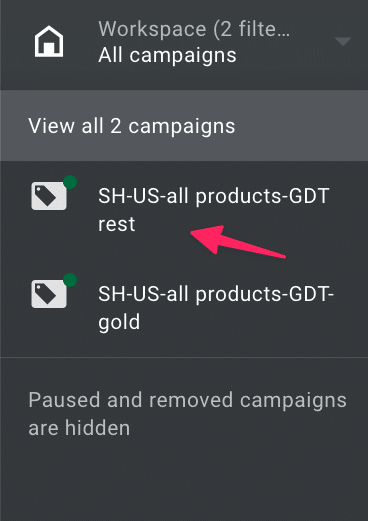
Next, select the Audiences tab. Click “edit audience segments”.
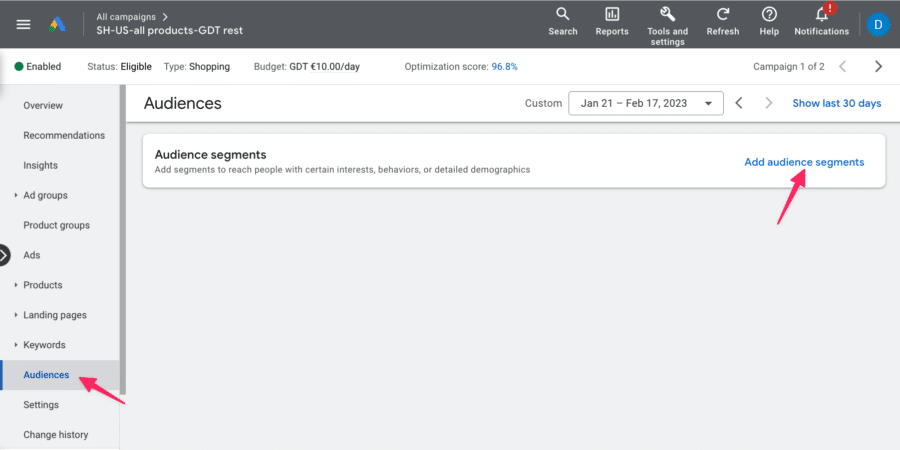
Then, select whether you want to add the audience on the Campaign, or the Ad group level:
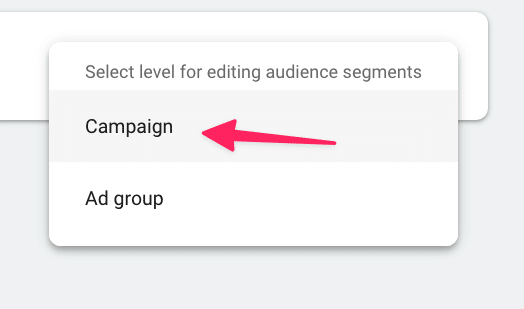
Select Observation mode.

Next, select Browse > “How they have interacted with your business” > Website visitors.
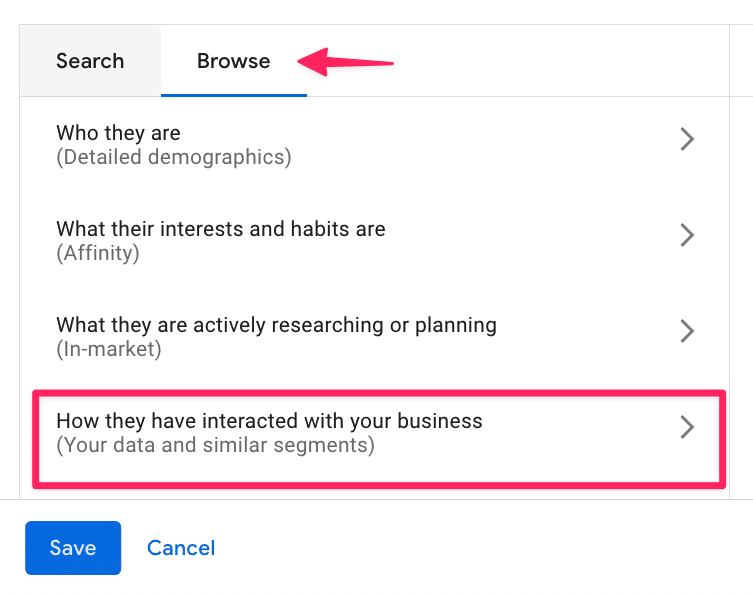
Then, add all the audience segments that are relevant to this campaign or ad group.
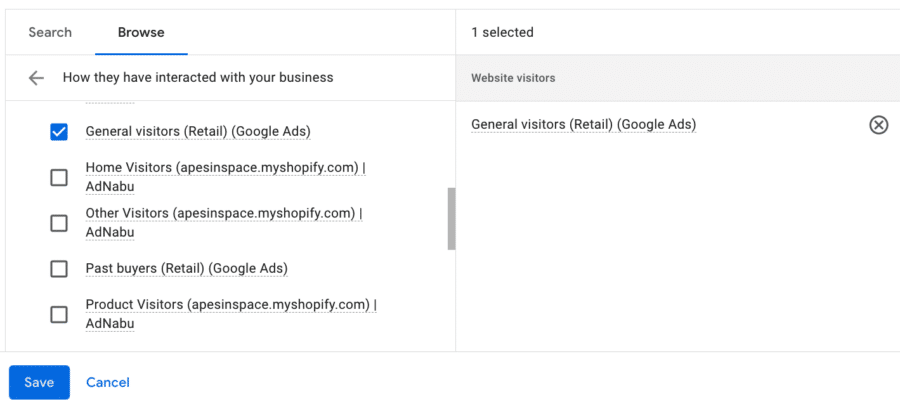
Note: you can add all of the audiences you want. If you happened to include one which doesn’t hit the necessary audience size (1000 for the Search network), Google will show a warning afterward.
Next, you can increase or decrease the bid adjustment for that particular audience.
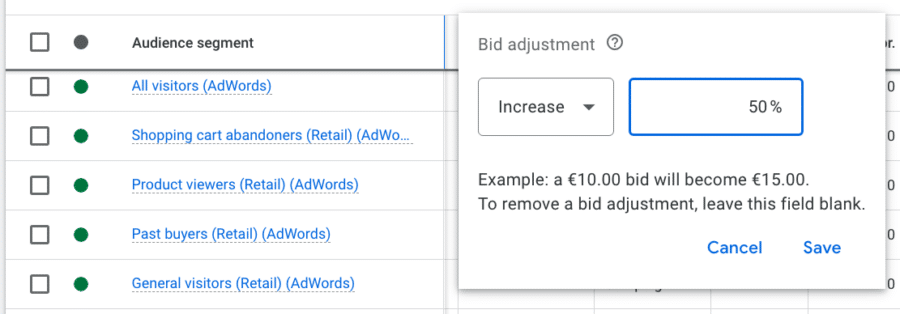
Create Dedicated RLSA Campaigns (Targeting Mode)
To create a specific RLSA campaign, you first create a campaign as you would normally do it.
Then follow the steps outlined above.
But when you start adding audiences, you’ll add them as “Targeting” instead of “Observation”.
This makes sure the campaign ONLY targets users on that list.
Select Targeting mode.
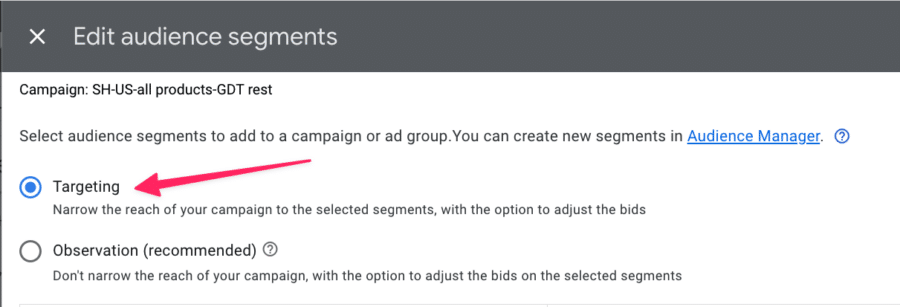
Remarketing Lists for Search Ads Are Worth the Try
Search remarketing has a small reach because two conditions need to be satisfied for an ad to be triggered: a user has to be on a remarketing list and search for a query we’re targeting.
Websites with high traffic (more than 100k per month) will see better results from RLSA targeting. Their audience is big enough, so a lot of users can satisfy the two conditions in order to end up in an RLSA campaign.
Smaller stores can leverage the lack of traffic by adding search remarketing audiences to their existing campaigns.
The biggest reason why RLSA can work so well is that you’re able to increase bids for users that have been to your site.
This increases the likelihood of them converting, meaning you can bid higher.
I highly recommend trying them out if you are looking for a way to make the most of your retargeting lists.
